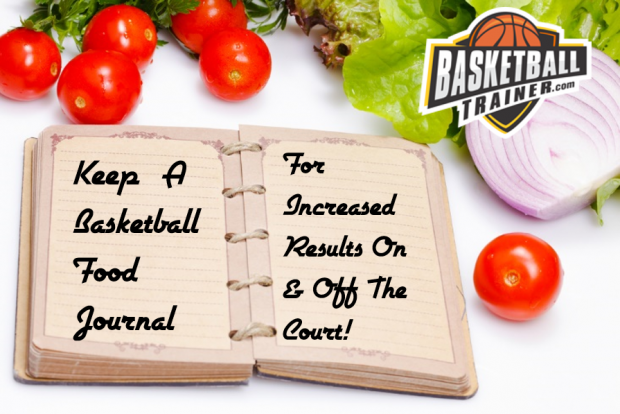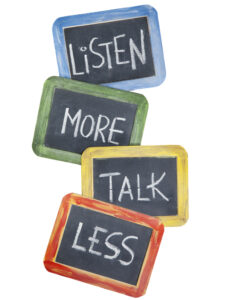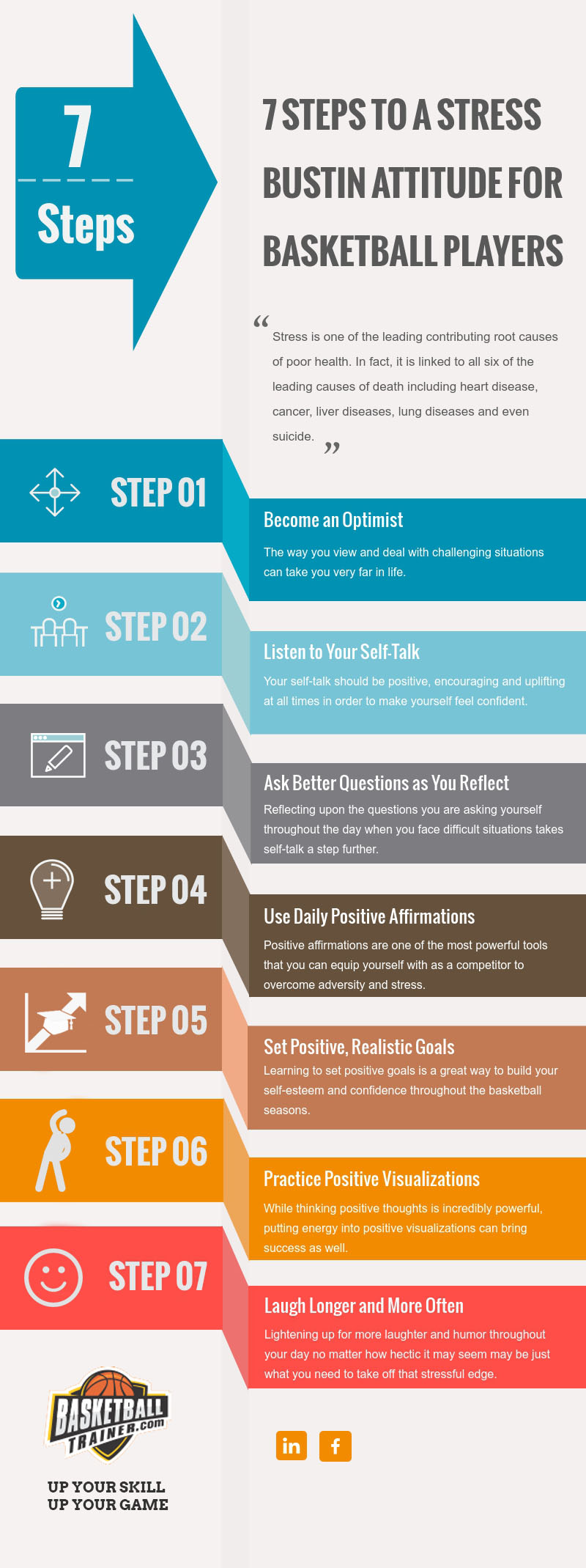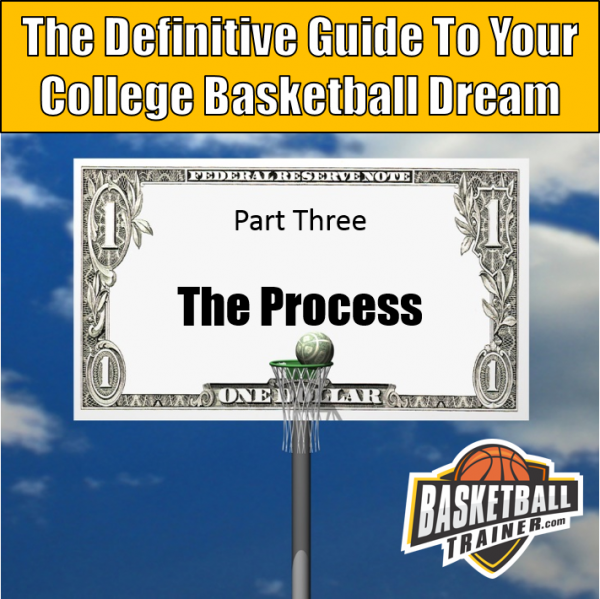
Basketball Food Journal – What is That?
A basketball food journal, also known as a food log or food diary, is a daily form that serious players in basketball training use to track your nutrition intake over a set period of time.
I believe that all basketball players should keep a daily food journal for at least 2 weeks out of every month, if not just making it an ongoing part of their basketball nutrition strategy.
Keeping a food journal is fairly simple, yet does require an increased commitment to logging everything that you eat and drink for a set period of time. You can choose to either create your own personal food journal, buy or find a pre-made one online or even use a phone app such as My Fitness Pal. Whichever way you decide to go with logging your daily nutritional intake, be sure that it makes the most sense for your lifestyle and personality so that you will stick with it in the long run. We also recommend periodically sharing your food journal in your discussions with your basketball trainer so they can help you pinpoint between your peaks and valleys in performance.
A basic food journal for basketball players should at the very least include: what you are eating (try to be as specific as possible), what time you ate each meal/snack, a way to track your water intake, how much time has passed between each meal/snack, how you felt before and after you ate. More detailed journals centered on meeting specific goals like increasing muscle mass or reducing body fat percentage should include things like total calories along with fat, protein and carbohydrate content of each meal.
The most convenient time to log your food and fluid intake will be different for everyone. Some players may find it easier to jot things down after each meal and snack as they go along in their days, while others may have more success doing it all at the very end of their day. The only potential problem to waiting until the end of the day is the chance that you might forget to include something.
Making the decision to commit to tracking your nutritional intake as a basketball player can have a very positive impact on your overall health which will translate into your performance on the court. How can you know whether or not you are consistently fueling your body with the right types and amounts of foods if you don’t take the time to review your days and weeks? The bottom line is that you can’t, while it is effective to always choose as healthy foods as possible, sometimes it’s easy to overlook the fine details of your diet that could be causing you to perform at less than your best.
I’d like to share with you my top 4 reasons why every basketball player should keep a food journal at least from time to time.
Recognize patterns in your daily eating habits and basketball performance
– unless it’s written down, often it’s easy to overlook small details in your eating habits. Keeping a food journal will help you distinguish between what you think you may or may not be doing on a regular basis in your diet in comparison to what you actually are. For example, having everything written out will help you to pinpoint patterns like what kinds of food you tend to eat at certain points in the day, times that you may be waiting too long to eat your next meal or snack and you might even be surprised at your actual water intake.
Achieve specific basketball nutritional goals
– it’s difficult to achieve any goal without being able to measure success. A daily basketball food journal is a strategic and wise way to set yourself up to create the daily nutrition to meet your goals. Whether you are wanting to increase your muscle mass or even reduce some unwanted body fat, it’s important to know what and how much you are eating each day. Specific goals require specific action and a food journal is the easiest, most effective way to face the reality of what you are or aren’t putting into your body to get you to where you want to be physically to support your basketball performance in the least amount of time.
Plan your pre- and –post basketball workout meals
– on the days that you are busy, it can be easy to overlook the importance in fueling your body properly before and after a basketball practice, workout or game. Keeping a daily food journal can be especially helpful with you being able to choose the best foods and supplements to fuel your body with. Logging what you are eating before you play will allow you to see which foods give you more energy and which foods seem to slow you down out on the court. Also, it’s a great way to hold yourself accountable for getting in the best post workout nutrition possible after exerting yourself physically for hours. These two meals are the most important meals that a basketball player will eat aside from breakfast, so it’s important to recognize what you are fueling your body with consistently.
Keep up with your daily supplementation
– aside from food, including regular nutritional supplementation in your basketball game plan like taking a daily multi-vitamin can be incredibly beneficial. With so many things to remember in regards to healthy eating, sometimes remembering to take your supplements can slide under the radar. Including these in your daily food journaling efforts can help you keep up with what and when you need to take your nutritional support products each day.
As you’ve now learned, sometimes getting a little more pro-active with your basketball nutrition goals by keeping a periodic food journal can really elevate you and give you a strategic advantage to success. It’s always easier to make changes when you know exactly what areas you need to work on, rather than feeling like you’re drowning in changes that need to be made without any real idea of where to start.
Get ahead of the game and grab your pen and basketball food journal for healthier and more effective basketball nutrition!





 Amino acids are the building blocks of protein and are classified as either essential amino acids or non-essential amino acids. The body can make about half of the 20 amino acids that it needs which are known as the non-essential amino acids. The other 10 that the body cannot product on its own, known as essential amino acids, must be attained through diet and supplementation in order to keep up with the demands of a basketball body.
Amino acids are the building blocks of protein and are classified as either essential amino acids or non-essential amino acids. The body can make about half of the 20 amino acids that it needs which are known as the non-essential amino acids. The other 10 that the body cannot product on its own, known as essential amino acids, must be attained through diet and supplementation in order to keep up with the demands of a basketball body. The lifestyle of a basketball player is incredibly demanding. Aside from being under loads of stress and pressure to maintain good grades and healthy personal and professional relationships, the body must undergo hours of physical wear and tear so to speak. The entire body is left depleted often after basketball workouts, practices and games and is need of important protein replenishment. Without the right amount of protein to support your basketball body, you will be left with a weakened immune system, less muscle mass, as well as being more likely to fill your diet with too many carbohydrates and fats which can lead to an undesirable body fat percentage.
The lifestyle of a basketball player is incredibly demanding. Aside from being under loads of stress and pressure to maintain good grades and healthy personal and professional relationships, the body must undergo hours of physical wear and tear so to speak. The entire body is left depleted often after basketball workouts, practices and games and is need of important protein replenishment. Without the right amount of protein to support your basketball body, you will be left with a weakened immune system, less muscle mass, as well as being more likely to fill your diet with too many carbohydrates and fats which can lead to an undesirable body fat percentage. After calculating the minimum amount of protein you should be consuming each day, go ahead and jot it down in your food journal as you begin tracking your daily intake to ensure that you’re getting enough.
After calculating the minimum amount of protein you should be consuming each day, go ahead and jot it down in your food journal as you begin tracking your daily intake to ensure that you’re getting enough. Most athletes add in the protein powder mixes, because they are delicious, lower sugar and can be taken on-the-go and simply mixed with your choice of water, milk or a milk alternative. Some of the shake formulations are complete meal replacements featuring vitamins, minerals and superfoods and superfruits while other products are just protein. Still others look to smoothies to add or maintain weight in baksetball training. Here is a good resource for that:
Most athletes add in the protein powder mixes, because they are delicious, lower sugar and can be taken on-the-go and simply mixed with your choice of water, milk or a milk alternative. Some of the shake formulations are complete meal replacements featuring vitamins, minerals and superfoods and superfruits while other products are just protein. Still others look to smoothies to add or maintain weight in baksetball training. Here is a good resource for that:  A couple of my favorite healthy protein bars include:
A couple of my favorite healthy protein bars include: When you walk into any nutritional supplement store like the Vitamin Shoppe or GNC, you will notice that there are different types of protein powders to choose from which can be very confusing.
When you walk into any nutritional supplement store like the Vitamin Shoppe or GNC, you will notice that there are different types of protein powders to choose from which can be very confusing.
 You know those players that seem to always have something to say about everything regardless of whether it’s in response to a reprimand or when they make a good play? Typically those players are not very good listeners and tend to go about simply running their mouths for the sake of hearing themselves talk. This is not a good example of a coachable player, in fact, just the opposite type of player is ideal. By listening more and talking less you are showing that you believe what your coaches have to say is more important and you are more likely to retain what they are teaching you than if you are always talking while they are or interrupting them.
You know those players that seem to always have something to say about everything regardless of whether it’s in response to a reprimand or when they make a good play? Typically those players are not very good listeners and tend to go about simply running their mouths for the sake of hearing themselves talk. This is not a good example of a coachable player, in fact, just the opposite type of player is ideal. By listening more and talking less you are showing that you believe what your coaches have to say is more important and you are more likely to retain what they are teaching you than if you are always talking while they are or interrupting them. It’s not always easy to take personal responsibility whether in life or on the basketball court. It’s especially challenging when coming into practice after a lousy game performance where you missed most of your free throws or allowed your player too many offensive points that was a big part in costing your team the game. Those are the moments that are tough to swallow knowing that you might have let some people down. Coachable players understand that this is all part of the self-development process as an athlete and you have to be willing to take the good times with the bad. You can’t always accept the glory without being able to tough out the failures as well. Taking personal responsibility for your daily performance shows your coaches that you are able to be realistic for where you are really at with your skills and within your role on the
It’s not always easy to take personal responsibility whether in life or on the basketball court. It’s especially challenging when coming into practice after a lousy game performance where you missed most of your free throws or allowed your player too many offensive points that was a big part in costing your team the game. Those are the moments that are tough to swallow knowing that you might have let some people down. Coachable players understand that this is all part of the self-development process as an athlete and you have to be willing to take the good times with the bad. You can’t always accept the glory without being able to tough out the failures as well. Taking personal responsibility for your daily performance shows your coaches that you are able to be realistic for where you are really at with your skills and within your role on the  This trait goes along with the previous one in that the most coachable players are always focusing on inner reflection rather than looking to their coaches and their teammates to justify their behavior or performance. Instead of worrying about your point guard who seems to always turn the ball over on every other play or your post player who refuses to use the backboard and has a frustratingly low shooting percentage, simply spend your time thinking about the areas that you need to improve. The best, more effective players in the game of
This trait goes along with the previous one in that the most coachable players are always focusing on inner reflection rather than looking to their coaches and their teammates to justify their behavior or performance. Instead of worrying about your point guard who seems to always turn the ball over on every other play or your post player who refuses to use the backboard and has a frustratingly low shooting percentage, simply spend your time thinking about the areas that you need to improve. The best, more effective players in the game of  Has your coach ever said something to you during practice that didn’t quite make sense or that you didn’t completely catch? Coachable players understand that communication is key to success and when there is a misunderstanding between coach and player it’s not just the coach’s responsibility to ensure that everything is clear from a communication aspect. Your coach will respect you more if you take the time to show up to practice early or stay late to drop by their office to keep lines of communication open. It can be an incredibly difficult challenge for
Has your coach ever said something to you during practice that didn’t quite make sense or that you didn’t completely catch? Coachable players understand that communication is key to success and when there is a misunderstanding between coach and player it’s not just the coach’s responsibility to ensure that everything is clear from a communication aspect. Your coach will respect you more if you take the time to show up to practice early or stay late to drop by their office to keep lines of communication open. It can be an incredibly difficult challenge for  This is one of the most difficult traits to develop as you become a coachable basketball player. It’s easy to think that after the 5th time of your coach or teammate coming to you about the same issue that you are simply being criticized for your hard efforts. By keeping everything in a positive perspective and remembering that you can’t always take tone of voice, facial expressions and other bodily language so literally you will be happier. Sometimes, your coaches and teammates are going to say things that might come across as abrupt and critical, but so long as you keeping in mind that they are all human and you choose to always hear instruction over criticism you will soar as a coachable
This is one of the most difficult traits to develop as you become a coachable basketball player. It’s easy to think that after the 5th time of your coach or teammate coming to you about the same issue that you are simply being criticized for your hard efforts. By keeping everything in a positive perspective and remembering that you can’t always take tone of voice, facial expressions and other bodily language so literally you will be happier. Sometimes, your coaches and teammates are going to say things that might come across as abrupt and critical, but so long as you keeping in mind that they are all human and you choose to always hear instruction over criticism you will soar as a coachable 

 As you go throughout your day you will notice that you are always talking to yourself. Sometimes what you are saying is positive and sometimes it’s negative. By beginning to pay closer attention to the way you are talking to yourself you can gain a great idea of why you tend be more positive or negative in general. Your
As you go throughout your day you will notice that you are always talking to yourself. Sometimes what you are saying is positive and sometimes it’s negative. By beginning to pay closer attention to the way you are talking to yourself you can gain a great idea of why you tend be more positive or negative in general. Your  Reflecting upon the questions you are asking yourself throughout the day when you face difficult situations takes self-talk a step further. It’s easy to fall into a negative, stress inducing pattern of beating ourselves up with self-defeating questions like, “Why do I always miss my second free throw?” or “Why do I always have to mess up that play?” Instead, ask yourself questions that are going to help you overcome the situation or circumstance like “What do I need to learn from my failed attempts to make it better the next time?” or “How can I adjust my form and visualize my shots going in so that I can improve my free throw percentage?” These are the kinds of questions that are focused on the positive and are going to get you much better results.
Reflecting upon the questions you are asking yourself throughout the day when you face difficult situations takes self-talk a step further. It’s easy to fall into a negative, stress inducing pattern of beating ourselves up with self-defeating questions like, “Why do I always miss my second free throw?” or “Why do I always have to mess up that play?” Instead, ask yourself questions that are going to help you overcome the situation or circumstance like “What do I need to learn from my failed attempts to make it better the next time?” or “How can I adjust my form and visualize my shots going in so that I can improve my free throw percentage?” These are the kinds of questions that are focused on the positive and are going to get you much better results. Positive affirmations are one of the most powerful tools that you can equip yourself with as a competitor to overcome adversity and stress. Affirmations are things that we believe and they become imprinted on our subconscious mind, so regardless of whether you are consciously thinking a positive or negative thought at the time, what your subconscious believes is typically how you will behave when you are faced with stress. For example, if you believe that you are not a
Positive affirmations are one of the most powerful tools that you can equip yourself with as a competitor to overcome adversity and stress. Affirmations are things that we believe and they become imprinted on our subconscious mind, so regardless of whether you are consciously thinking a positive or negative thought at the time, what your subconscious believes is typically how you will behave when you are faced with stress. For example, if you believe that you are not a  Learning to set positive goals is a great way to
Learning to set positive goals is a great way to  While thinking positive thoughts is incredibly powerful, putting energy into positive visualizations can bring success as well. How about picturing yourself hitting the game winning shot before you even take it, or how about seeing yourself shutting down the other teams’ best player? If you can create visualization in your
While thinking positive thoughts is incredibly powerful, putting energy into positive visualizations can bring success as well. How about picturing yourself hitting the game winning shot before you even take it, or how about seeing yourself shutting down the other teams’ best player? If you can create visualization in your  Lightening up for more laughter and humor throughout your day no matter how hectic it may seem may be just what you need to take off that stressful edge. In fact, making time to laugh often is the most powerful stress-buster around. Research and studies are also now showing that laughing has the potential to boost the immune system as well considering that stress levels and immunity do go hand-in-hand.
Lightening up for more laughter and humor throughout your day no matter how hectic it may seem may be just what you need to take off that stressful edge. In fact, making time to laugh often is the most powerful stress-buster around. Research and studies are also now showing that laughing has the potential to boost the immune system as well considering that stress levels and immunity do go hand-in-hand.









 In an effort to gain more exposure prospects will often attend showcase events run by a variety of different organizations in the summer, fall and spring. Showcase events also occur during the high school season when organizers look to schedule multiple games pitting non-conference opponents against each other in a day-long, weekend or a holiday setting drawing recruiters while they look to cash in on sponsors, fans, concessions and merchandise. Showcases are very often attended by college, prep and junior college coaches from all levels and give kids a chance to really make a great impression. However, prospects can also often leave these events overwhelmed, intimidated and under the radar with such an influx of talent all at one location in a condensed time setting. Various factors including politicking by high school and all-star coaches as well as parents and even the showcase promoters cause a high percentage of quality prospects to miss out. These events have become platforms for grassroots organizers to promote their product while putting on a great show which showcases individualized play.
In an effort to gain more exposure prospects will often attend showcase events run by a variety of different organizations in the summer, fall and spring. Showcase events also occur during the high school season when organizers look to schedule multiple games pitting non-conference opponents against each other in a day-long, weekend or a holiday setting drawing recruiters while they look to cash in on sponsors, fans, concessions and merchandise. Showcases are very often attended by college, prep and junior college coaches from all levels and give kids a chance to really make a great impression. However, prospects can also often leave these events overwhelmed, intimidated and under the radar with such an influx of talent all at one location in a condensed time setting. Various factors including politicking by high school and all-star coaches as well as parents and even the showcase promoters cause a high percentage of quality prospects to miss out. These events have become platforms for grassroots organizers to promote their product while putting on a great show which showcases individualized play.  New York City is known as a breeding ground for point guards. Nate Archibald (Bronx), Mark Jackson (Brooklyn), Earl “The Pearl” Washington (Brooklyn), Bob Cousy (Cambria Heights), Sebastian Telfair (Brooklyn) and Kenny Anderson (Queens) to name just a few have given the world of basketball some of the best pure point guards ever seen.[2] On the flip side of the city life, there are the Larry Bird-prospects that rise to the NBA from rural small towns in underpopulated remote areas. The
New York City is known as a breeding ground for point guards. Nate Archibald (Bronx), Mark Jackson (Brooklyn), Earl “The Pearl” Washington (Brooklyn), Bob Cousy (Cambria Heights), Sebastian Telfair (Brooklyn) and Kenny Anderson (Queens) to name just a few have given the world of basketball some of the best pure point guards ever seen.[2] On the flip side of the city life, there are the Larry Bird-prospects that rise to the NBA from rural small towns in underpopulated remote areas. The 
 The NCAA also require SAT or ACT minimum “sliding scale” scores for admissions. The sliding scale is in place to give students flexibility in regards to their low GPA or test scores.[10] To qualify to play intercollegiate athletics at the NAIA level, students must meet two out of the following three requirements; a minimum of 18 on the ACT or 860 on the SAT (Critical Reading and Match only), earn an overall high school GPA of 2.0 on a 4.0 scale and/or graduate in the top 50% of their graduating class.[11] The NAIA offers the two out of three instead of the NCAA sliding scale test score method but both have the same purpose, give lower academic students some flexibility to become eligible. Passing through NCAA and/or NAIA Eligibility Center does not guarantee admission into a given school. The final decision for acceptance to a school and the completion of The Process lies in the hands of the admissions department at each respective institution.
The NCAA also require SAT or ACT minimum “sliding scale” scores for admissions. The sliding scale is in place to give students flexibility in regards to their low GPA or test scores.[10] To qualify to play intercollegiate athletics at the NAIA level, students must meet two out of the following three requirements; a minimum of 18 on the ACT or 860 on the SAT (Critical Reading and Match only), earn an overall high school GPA of 2.0 on a 4.0 scale and/or graduate in the top 50% of their graduating class.[11] The NAIA offers the two out of three instead of the NCAA sliding scale test score method but both have the same purpose, give lower academic students some flexibility to become eligible. Passing through NCAA and/or NAIA Eligibility Center does not guarantee admission into a given school. The final decision for acceptance to a school and the completion of The Process lies in the hands of the admissions department at each respective institution. A typical admissions checklist for a college or university will include an application ($40 fee), official high school transcripts, letter of recommendation and a brief essay. Admissions departments will also encourage a campus visit and once they have the prospective student touring their grounds, they will conduct an interview. More and more schools have moved to the on-line approach of recruiting which enables them to attract and filter through large numbers of recruits without physically having them on-campus. While college coaches are targeting student-athletes for their teams as early as middle schools, the admissions process typically begins junior year in high school when students, guidance counselors along with parents and or guardians will target schools and map out some possible campus visits. Some highly regarded academic high schools have students begin this process their sophomore year but generally some prep work and “feeling out” is done junior year and The Process really takes flight senior year. Students will prepare essays (1-2 pages), gather letters of recommendation (usually 1 or 2 from a teach, guidance counselor or other school official) and official transcripts (complete with grades, class rank and test scores) while deciding which colleges they would like to apply to and figure out if they want to go for early or general admissions to the chosen institution(s).[12] Once application files are complete, schools make a decision and put the ball in the court of the recruit.
A typical admissions checklist for a college or university will include an application ($40 fee), official high school transcripts, letter of recommendation and a brief essay. Admissions departments will also encourage a campus visit and once they have the prospective student touring their grounds, they will conduct an interview. More and more schools have moved to the on-line approach of recruiting which enables them to attract and filter through large numbers of recruits without physically having them on-campus. While college coaches are targeting student-athletes for their teams as early as middle schools, the admissions process typically begins junior year in high school when students, guidance counselors along with parents and or guardians will target schools and map out some possible campus visits. Some highly regarded academic high schools have students begin this process their sophomore year but generally some prep work and “feeling out” is done junior year and The Process really takes flight senior year. Students will prepare essays (1-2 pages), gather letters of recommendation (usually 1 or 2 from a teach, guidance counselor or other school official) and official transcripts (complete with grades, class rank and test scores) while deciding which colleges they would like to apply to and figure out if they want to go for early or general admissions to the chosen institution(s).[12] Once application files are complete, schools make a decision and put the ball in the court of the recruit. Financial planning and financial aid are often a deal breaker in the recruits’ decision to where they go to school. While the hope is that students will be able to afford college with a full-ride athletic scholarship (Part 1) or some sort of family trust, nest egg or a big dip into savings, the reality is that two thirds[13] of all students take advantage of academic merit scholarships, athletic scholarships and/or FAFSA as discussed in Part 2 (link or even excerpt here). Students can apply for FAFSA beginning on January 1 of their senior year in high school. Early application is encouraged as much of the funds are awarded first come, first serve once the need is determined to be equal. The Process for the ‘average’
Financial planning and financial aid are often a deal breaker in the recruits’ decision to where they go to school. While the hope is that students will be able to afford college with a full-ride athletic scholarship (Part 1) or some sort of family trust, nest egg or a big dip into savings, the reality is that two thirds[13] of all students take advantage of academic merit scholarships, athletic scholarships and/or FAFSA as discussed in Part 2 (link or even excerpt here). Students can apply for FAFSA beginning on January 1 of their senior year in high school. Early application is encouraged as much of the funds are awarded first come, first serve once the need is determined to be equal. The Process for the ‘average’  Put quite simply, the more a coach wants a player, the more attention he or she is going to get during The Process. However, recruits should never stop trying to prove themselves and should not settle for a team because it is local, or their sibling or friend is there or because they are being pushed there by a community, parents, high school coach or some other outside influence. If you are looking to get a start in narrowing down college choices that might be a fit for you, then I recommend you use a tool developed by a company I am involved with. The Sport Source has a tool that is free for 24 hours use that permits you to input some of your criteria and also qualifications and then helps create a personalized database of which schools could be a fit for you.
Put quite simply, the more a coach wants a player, the more attention he or she is going to get during The Process. However, recruits should never stop trying to prove themselves and should not settle for a team because it is local, or their sibling or friend is there or because they are being pushed there by a community, parents, high school coach or some other outside influence. If you are looking to get a start in narrowing down college choices that might be a fit for you, then I recommend you use a tool developed by a company I am involved with. The Sport Source has a tool that is free for 24 hours use that permits you to input some of your criteria and also qualifications and then helps create a personalized database of which schools could be a fit for you. 


 Water is the most important source of life on Earth. You can survive more than three weeks without food, but water is a completely different story. It would only take about three days for you to perish without this precious life source.
Water is the most important source of life on Earth. You can survive more than three weeks without food, but water is a completely different story. It would only take about three days for you to perish without this precious life source. As you are first starting out, it’s important to keep track of how much water you are or aren’t drinking each day. Keeping a daily water log might give you surprising answers since it’s impossible to keep up with fluid intakes by memory. You will learn exactly how much you need to increase your water intake or maybe you will find that you are doing just fine.
As you are first starting out, it’s important to keep track of how much water you are or aren’t drinking each day. Keeping a daily water log might give you surprising answers since it’s impossible to keep up with fluid intakes by memory. You will learn exactly how much you need to increase your water intake or maybe you will find that you are doing just fine.
 “Do your homework!” is a common school night phrase in households worldwide for students growing up. Prospects would be wise to listen to this advice. In fact, “there is 22 times more academic aid available (each year) than athletic scholarships.”[1] The more intelligent the
“Do your homework!” is a common school night phrase in households worldwide for students growing up. Prospects would be wise to listen to this advice. In fact, “there is 22 times more academic aid available (each year) than athletic scholarships.”[1] The more intelligent the  Additionally, prospects that do well in The Numbers Game often take advantage of the Free Application for Federal Student Aid, better known as FAFSA, which is a form that can be prepared annually for United States students looking for financial assistance for undergraduate and post-graduate studies within their country. The application awards aid of a given student based on Expected Family Contribution (EFC) which is determined by household size, income, number of students from household in college and assets.[3] The U.S. Department of Education begins accepting applications January 1 of each year and prospective students are encouraged to apply quickly to ensure that they will get as much aid as possible. FAFSA will open the door to nine federal student-aid programs, 605 state aid programs and most of the institutional aid available from a school of the student’s choice.[4] From a
Additionally, prospects that do well in The Numbers Game often take advantage of the Free Application for Federal Student Aid, better known as FAFSA, which is a form that can be prepared annually for United States students looking for financial assistance for undergraduate and post-graduate studies within their country. The application awards aid of a given student based on Expected Family Contribution (EFC) which is determined by household size, income, number of students from household in college and assets.[3] The U.S. Department of Education begins accepting applications January 1 of each year and prospective students are encouraged to apply quickly to ensure that they will get as much aid as possible. FAFSA will open the door to nine federal student-aid programs, 605 state aid programs and most of the institutional aid available from a school of the student’s choice.[4] From a  As discussed in Part I, NCAA D1 schools are the only programs that offer exclusive full rides. However, there are very few available in a given recruiting year. Although NCAA D2 can offer full ride athletic scholarships, it is not the norm and very often, coaches will try to maximize their athletic scholarship money by recruiting prospects that are able to draw from other resources such as merit scholarships and/or a substantial FAFSA package. All NCAA D2 sports are considered “equivalency” sports, which means that the NCAA restricts the total financial aid that a school can offer in a given sport such as basketball to the equivalent of a set number of full scholarships.[5] These programs have a total of 10 athletic scholarships available in men’s and women’s basketball while NCAA D3 programs do not offer athletic money. The problem is some institutions and in some cases entire conferences choose not to offer the full allotment granted by the NCAA. In addition, Coaches simply don’t have many scholarships available in a given year and will often look to offer partial scholarships to try to get as many players as possible. They may sometimes pitch a “pay two, earn two” situation to prospects in which they receive no athletic scholarship money their first two years but if they remain in the program, get an athletic scholarship their last two years. D2 coaches do try to land the big fish but most full rides at the D2 level are reserved for NCAA D1 transfers who can come in and make an immediate impact in the win column. In NAIA D1, basketball is sponsored by just over 100 men’s and women’s programs with each team offering a maximum of 11 athletic scholarships. In NAIA D2, there are nearly 150 men’s and women’s teams with each program equipped with the equivalent of six scholarships. NAIA coaches operate very similar to NCAA D2 coaches offering full rides to mainly NCAA D1 transfers while looking to fill their rosters utilizing partial scholarships, especially at the NAIA D2 level where they only have a maximum of six full scholarships. The best bet in The Numbers
As discussed in Part I, NCAA D1 schools are the only programs that offer exclusive full rides. However, there are very few available in a given recruiting year. Although NCAA D2 can offer full ride athletic scholarships, it is not the norm and very often, coaches will try to maximize their athletic scholarship money by recruiting prospects that are able to draw from other resources such as merit scholarships and/or a substantial FAFSA package. All NCAA D2 sports are considered “equivalency” sports, which means that the NCAA restricts the total financial aid that a school can offer in a given sport such as basketball to the equivalent of a set number of full scholarships.[5] These programs have a total of 10 athletic scholarships available in men’s and women’s basketball while NCAA D3 programs do not offer athletic money. The problem is some institutions and in some cases entire conferences choose not to offer the full allotment granted by the NCAA. In addition, Coaches simply don’t have many scholarships available in a given year and will often look to offer partial scholarships to try to get as many players as possible. They may sometimes pitch a “pay two, earn two” situation to prospects in which they receive no athletic scholarship money their first two years but if they remain in the program, get an athletic scholarship their last two years. D2 coaches do try to land the big fish but most full rides at the D2 level are reserved for NCAA D1 transfers who can come in and make an immediate impact in the win column. In NAIA D1, basketball is sponsored by just over 100 men’s and women’s programs with each team offering a maximum of 11 athletic scholarships. In NAIA D2, there are nearly 150 men’s and women’s teams with each program equipped with the equivalent of six scholarships. NAIA coaches operate very similar to NCAA D2 coaches offering full rides to mainly NCAA D1 transfers while looking to fill their rosters utilizing partial scholarships, especially at the NAIA D2 level where they only have a maximum of six full scholarships. The best bet in The Numbers  In conclusion, The Number Game in College
In conclusion, The Number Game in College 





